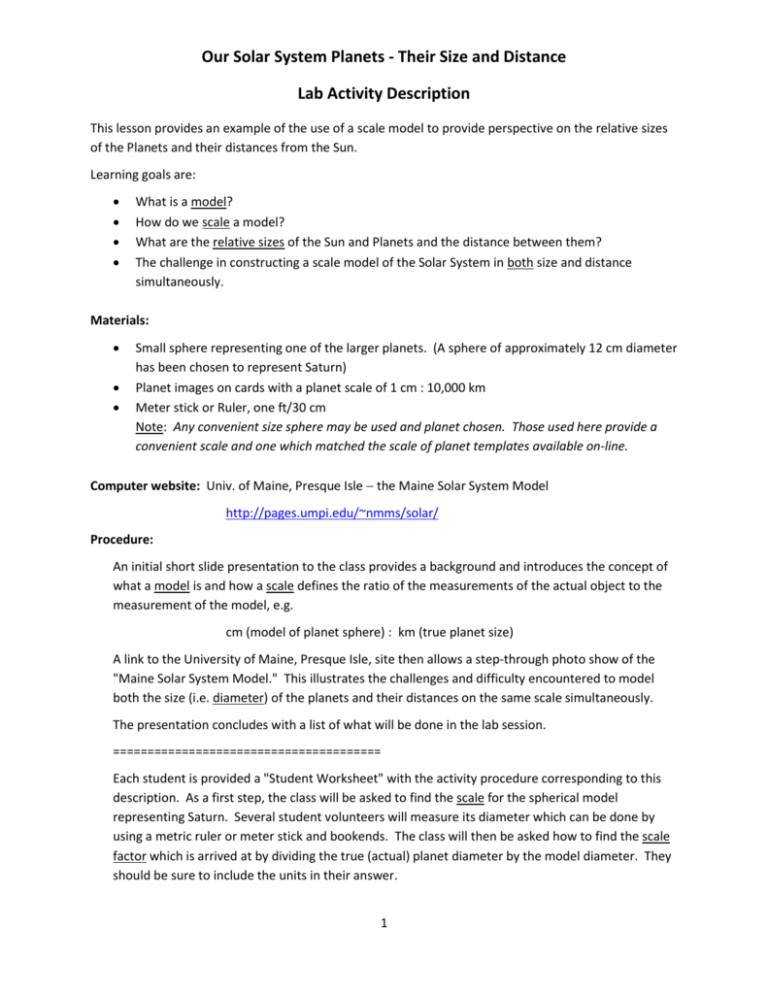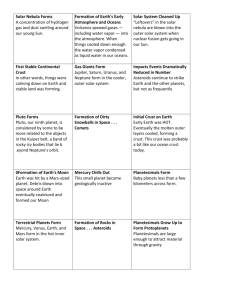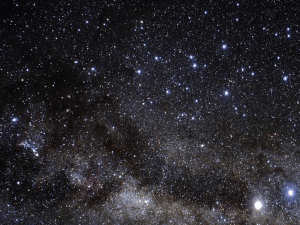Planet Sizes & Distances, Lab Description_final - RE-SEED
advertisement

Our Solar System Planets - Their Size and Distance Lab Activity Description This lesson provides an example of the use of a scale model to provide perspective on the relative sizes of the Planets and their distances from the Sun. Learning goals are: What is a model? How do we scale a model? What are the relative sizes of the Sun and Planets and the distance between them? The challenge in constructing a scale model of the Solar System in both size and distance simultaneously. Materials: Small sphere representing one of the larger planets. (A sphere of approximately 12 cm diameter has been chosen to represent Saturn) Planet images on cards with a planet scale of 1 cm : 10,000 km Meter stick or Ruler, one ft/30 cm Note: Any convenient size sphere may be used and planet chosen. Those used here provide a convenient scale and one which matched the scale of planet templates available on-line. Computer website: Univ. of Maine, Presque Isle the Maine Solar System Model http://pages.umpi.edu/~nmms/solar/ Procedure: An initial short slide presentation to the class provides a background and introduces the concept of what a model is and how a scale defines the ratio of the measurements of the actual object to the measurement of the model, e.g. cm (model of planet sphere) : km (true planet size) A link to the University of Maine, Presque Isle, site then allows a step-through photo show of the "Maine Solar System Model." This illustrates the challenges and difficulty encountered to model both the size (i.e. diameter) of the planets and their distances on the same scale simultaneously. The presentation concludes with a list of what will be done in the lab session. ======================================= Each student is provided a "Student Worksheet" with the activity procedure corresponding to this description. As a first step, the class will be asked to find the scale for the spherical model representing Saturn. Several student volunteers will measure its diameter which can be done by using a metric ruler or meter stick and bookends. The class will then be asked how to find the scale factor which is arrived at by dividing the true (actual) planet diameter by the model diameter. They should be sure to include the units in their answer. 1 Our Solar System Planets - Their Size and Distance Lab Activity Description It may help to write on the blackboard, although this information is also in the table of their worksheet, 120,540 km = the diameter of Saturn and, 1,427,000,000 = the average distance of Saturn from the Sun The result will be approximately 10,000 km/cm for the sphere and planet (Saturn) chosen. Explain that the result is the scale of the model and is customarily written as 1 cm : 10,000 km The next step will be to have them convert the actual size and distance of all the planets given in their worksheet table to that same scale, and record their results in columns 3 and 5 respectively. For this exercise the class (about 25-30 students) can be divided into teams of three and each team assigned to only one of the planets. It will be helpful to write the filled-in table results on the blackboard (or projected transparency) as the teams arrive at them. Then explain that a set of planet image cards at this same scale is available and provide each team their assigned planet card to check their calculated size (by measuring the diameter of the planet image on the card). As discussion, have students observe the very large planet distances from the Sun required to maintain this same scale. Explain that the size of the planets and their distance from the Sun are now consistent at this scale. Point out that virtually all the illustrations and models they will be exposed to are not to scale and therefore do not represent the real relationship in relative size and distance from one to the other. ======================================= Next we introduce the students to a new unit, the Astronomical Unit (AU), as a convenient unit for expressing large solar system distances. Write on the blackboard, 1 Astronomical Unit (AU) the average distance of the Earth from the Sun = 150,000,000 km Now ask each team to convert the actual (true) distances given in their worksheet table to this new unit for their assigned planet, and record their result in column 6 of the table. They should know to divide the true (actual) distances by 150,000,000. The next step will be to form a planet distance model that will fit inside the lab room by defining as a scale, and writing on the blackboard, 1 Astronautical Unit (AU) = 1 Lab floor tile Each team will now place a marker or a piece of masking tape with their planet name at the position where their planet would be located on this scale, starting from a marked (tape) line on the floor that indicates the location of the Sun. Explain that this is a planet distance model that now fits in the lab room. 2 Our Solar System Planets - Their Size and Distance Lab Activity Description As discussion, recall the Maine Solar System Model, shown earlier in the presentation, and point out that the scale used there was actually 1 mile (1.6km) per AU, although not explicitly stated as such. Wrap-up Discussion: As time permits, ask the students What observations they can make about this lab room planet distance model, and the usefulness of the Astronomical Unit (AU)? What would happen to the size of the planets if they were to be scaled and placed in this model? For comparison, recall the Maine Solar System Model. (A bonus exercise below pertains to this). What can they say about the accuracy of the many illustrations and physical models that they see for the Solar System? Challenge them to figure out why they are not accurate (e.g. the Solar System illustration in the initial presentation). Bonus Exercise: As a post-lab assignment, students may calculate the diameters in centimeters of the Sun and the Earth (or all the planets) for the lab floor tile scale used above. They should assume that the floor tiles are 1 ft. square or about 30 cm. (The answers are 0.28 cm and 0.002 cm respectively) Filled-in Student Worksheet table: Scale: 1 centimeter : 10,000 kilometer Scale: 1 AU = 150,000,000 km 1 AU : 1 floor tile (1) (2) (3) (4) (5) (6) True Scaled True Distance Scaled Distance Scaled Distance Diameter Diameter from the Sun from the Sun from the Sun (kilometers) (centimeters) (AU) --- --- --- (kilometers) (centimeters) Sun 1,400,000 140.0 Mercury 4,878 0.5 58,000,000 5,800 0.4 Venus 12,104 1.2 108,000,000 10,800 0.7 Earth 12,756 1.3 150,000,000 15,000 1.0 Mars 6,794 0.7 228,000,000 22,800 1.5 Jupiter 142,800 14.3 778,000,000 77,800 5.2 Saturn 120,540 12.1 1,427,000,000 142,700 9.5 Uranus 51,200 5.1 2,871,000,000 287,100 19.1 Neptune 49,500 5.0 4,497,000,000 449,700 30.0 2,200 0.2 5,913,000,000 591,300 39.4 Pluto* * Dwarf planet 3









